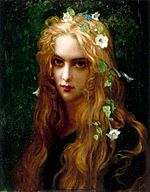Ernest Hébert
Ernest Hébert (born November 3, 1817 in La Tronche near Grenoble , † November 5, 1908 ibid), full name Antoine Auguste Ernest Hébert , was a French painter . He mainly devoted himself to landscape and genre painting , but also created some history paintings and portraits .
Life
Ernest Hébert, son of a notary of Grenoble, came in 1835 to Paris to law study. Although he also attended the workshops of the sculptor David d'Angers (1788-1856), and later the history painter Paul Delaroche (1797-1896), he largely acquired his artistic skills as an autodidact. At the age of 22, he achieved success with his painting Le Cup en prison at the Paris Salon . The Académie des Beaux-Arts awarded him the Prix de Rome in 1839 for the biblical composition Finding Joseph's Cup in Benjamin's Sack . The price was on a scholarship and a longer period of study in the Villa Medici connected in Rome, the fellows of the then under the guidance of the academic painter Jean-Auguste-Dominique Ingres (to 1840) and Jean-Victor Schnetz standing de Académie France à Rome was made available.
After his return, Hébert became the official court painter of Napoléon III. appointed. He achieved a triumphant success at the Paris Salon of 1850/51 with his most famous motif, entitled Malaria , a boat gliding along the Tiber with men and women suffering from fever. Hébert later continued his studies in the Dresden gallery and thereby consolidated himself in his direction, as The Girls from Alvito and The Fienarolen from San Germano prove.
From the end of 1866 to 1873 he was appointed director of the Académie de France in Rome for the first time. After his admission as a member of the Institut de France in 1874, he returned from 1885 to 1891 as director of the Académie de France in Rome.
Ernest Hébert died in 1908 shortly after he had turned 91 in his house in La Tronche, in whose garden he found his final resting place.
The Musée d'Orsay in Paris keeps several portrait photos of the artist, including one of Robert Jefferson Bingham from around 1870.
plant
Hébert first came to Rome in 1840 and, with interruptions, spent almost thirty years of his life in Italy, which became his adopted home. The fascination that this country exerted on him had a lasting impact on his work. He created poetic, sometimes melancholy landscape paintings in which he captured the light over the stretches of land in the vicinity of Rome, reproduced the ruggedness of the mountains of Cervara or depicted the atmosphere of the Pontine swamps . In genre pieces, he described the life and plight of the Italian people, especially the rural population, the hustle and bustle in the streets, and last but not least, the beauty of Italian women. He created the mosaic of the apse for the Paris Panthéon . In his final years he turned to portraiture and religious subjects.
A large part of his work is preserved in Paris in the Musée Hébert and in the artist's former villa in La Tronche.
Selection of works
- 1846: Danse orientale (oriental dance), La Tronche, Musée Hébert
- 1848/49: Malaria , Paris, Musée d'Orsay
- around 1850: Portrait de l'artiste (portrait of the artist or self-portrait), Compiègne
- around 1850: Portrait de Madame Hébert, mère de l'artiste (Portrait of Madame Hébert, mother of the artist), Paris, Musée Hébert
- 1852: Voie romaine dans un paysage orageux , La Tronche, Musée Hébert
- around 1853: Baiser de Judas (Judas Kiss), La Tronche, Musée Hébert
- around 1857: Les Fienaroles de San Germano , Paris, Musée Hébert
- 1858: Les Cervarolles (The Women of Cervara), Fountain Scene (exhibited in the Paris Salon in 1859), Paris, Musée d'Orsay
- 1867: Portrait de la princesse Christine Bonaparte (Portrait of Princess Christine Bonaparte), La Tronche, Musée Hébert
- ???: La Pastorella (issued in 1869)
- ???: La Lavandara (issued in 1869)
- 1871: Portraît de Monallucia , Paris, Musée Hébert
- 1872: Vierge de la Délivrance , La Tronche, Musée Hébert
- before 1873: Portrait de Napoléon III. , La Tronche, Musée Hébert
- 1875/84: wall mosaic, Paris, Panthéon
- 1880: La Musique (The Music), Paris, Musée du Petit Palais
- 1883: Petit Savoyard endormi , Paris, Musée Hébert
- around 1883: Petit Violoneux endormi , Paris, Musée Hébert
- 1892: Portrait de la baronne Eléonore d'Uckermann (Portrait of the Baroness Eléonore d'Uckermann), Paris, Musée Hébert
- around 1895: Le sommeil de l'enfant Jésus (The Sleep of the Baby Jesus), Paris, Musée Hébert
- 1897: La Marquise de Modène , Paris, Musée d'Orsay
- 1899: Portrait de la baronne de Laduye (Portrait of the Baroness of Laduye), La Tronche, Musée Hébert
- 1905: Portrait de Lily Schneider, comtesse de Ganay (Portrait of Lily Schneider, Countess of Ganay), La Tronche, Musée Hébert
literature
- Hébert, Ernest . In: Hans Vollmer (Hrsg.): General lexicon of fine artists from antiquity to the present . Founded by Ulrich Thieme and Felix Becker . tape 16 : Hansen – Heubach . EA Seemann, Leipzig 1923, p. 196 .
- Dictionnaire de la peinture française. La peinture en France du Moyen Age à nos jours. Larousse, 1991 Paris, ISBN 2-03-740011-X .
Web links
- Stéphane Guégan: Réouverture du Musée Hébert de La Tronche, près de Grenoble December 22, 2003 (French)
Individual proof
- ↑ Chronique italienne, dessins d'Ernest Hébert at musee-orsay.fr.
| personal data | |
|---|---|
| SURNAME | Hébert, Ernest |
| BRIEF DESCRIPTION | French painter |
| DATE OF BIRTH | November 3, 1817 |
| PLACE OF BIRTH | La Tronche near Grenoble |
| DATE OF DEATH | 5th November 1908 |
| Place of death | La Tronche near Grenoble |




